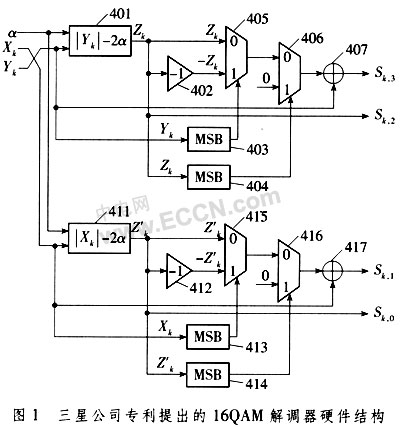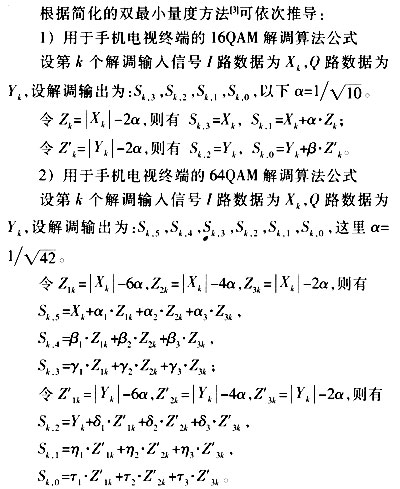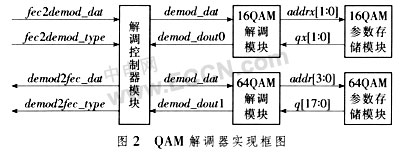l Introduction This article refers to the address: http:// When digital signals are transmitted on the actual communication channel, the digital signals received by the receiving end will inevitably generate errors due to unsatisfactory channel transmission characteristics and additive noise. In order to obtain a better error rate index within a certain range of signal-to-noise ratio, firstly, the baseband signal should be designed reasonably, and the modulation and demodulation mode should be selected. The techniques of time domain and frequency domain equalization should be used to reduce the bit error rate as much as possible. The modulation methods commonly used in communication systems are generally QPSK and M-order QAM modulation (M = 4, 8, 16, 32, 64, 256...). For QPSK modulation, the amplitudes of the modulation points are the same, but the phases are different, and the effects of signal-to-noise ratio and fading amplitude are not considered in demodulation. For QAM modulation, the amplitude and phase of the modulation point can be different. In this case, it is required to accurately understand the signal-to-noise ratio and the fading condition, so it should be considered in combination with channel estimation. In OFDM systems such as DVB-S, DVB-T, DVB-H, 802.16, in order to transmit more information bits, higher modulation methods are often used, such as 16QAM, 2QAM, 64QAM, etc. in baseband processing for solution. The method of withering is mainly divided into hard decision and soft decision. Since the performance of soft decision is better than hard decision, the soft information obtained by demodulation is generally input to the decoder for decoding. This scheme is feasible for CDMA systems because CDMA systems do not need to support 64QAM demodulation and the hardware complexity for 16QAM demodulation is acceptable. The log likelihood ratio (LLR) is calculated for the output bits when the soft decision is made, and the resulting LLR is used as the channel decoding input soft information value. This patent does not give the demodulation implementation of 64QAM, and its demodulation method is Gray mapping, but the mapping order of QAM is different from the QAM mapping order in mobile TV system. Therefore, the demodulation algorithm should be applied when applied to mobile TV terminals. Adjustment. This paper presents 16QAM demodulation and 64QAM demodulation schemes for mobile TV terminals. 4 hardware implementation The modulation data fec2demod_data is received by the demodulation controller module in FIG. 2, and after the modulation type fec2demod_type is analyzed and judged, the demodulated data demod_data is sent to the 16QAM demodulation module or the 64QAM demodulation module respectively: 16QAM demodulation, 16QAM The demodulation module sends the address addrx to the 16QAM parameter storage unit, and takes the demodulation parameter qx for processing. The 16QAM demodulation module sends the demodulated data demod_dout0 to the demodulation controller module; when the 64QAM is withered, the similarity is similar. However, the demodulation parameter is q, and the demodulated data is demod_dout1. After the completion of the solution, the demodulation controller module sends the demodulated data demod2fec_data and the modulation type demod2fec_type to the next-level decoding module.       Through algorithm simulation, the algorithm adopted in this paper can meet the performance requirements of mobile TV terminals through FPGA hardware. The hardware implementation of this paper only needs 2 ROM (read only memory) and a small number of logic circuits. The size of one ROM is 2×4 bit. Another ROM size is 18×16 bil, which occupies a small chip area and the two-star scheme only gives 16QAM demodulation implementation. Using a similar scheme to achieve 64QAM demodulation requires a large number of multiplexers and occupied chip area. Larger, through the above analysis, the demodulator designed in this paper can realize 16QAM and 64QAM demodulation, can apply the baseband chip of ten mobile TV terminal, and the hardware implementation is simple, saving the overall cost of the baseband chip.
Extrusion Neon LED Strip the hottest product in the world. It is extruded and has good waterproof performance.
The milky white cover makes the led strips soft and even, single color and RGB ,colorful and other colors are optional
and the external controller can achieve the effect. IP68 waterproof can be used for outdoor decoration,
often used for building decoration, Christmas decoration and other places. The installation is simple and convenient,
the repair is simple, and the scope of application is wide.
Extrusion Neon Led Strip LED Neon Lights,Neon LED Strip Lights,Extrusion LED Neon Flex Strip,Extrusion Neon LED Strip SHEN ZHEN SEL LIGHTING CO.,LTD , https://www.sellighting.com
The sTiMi mobile TV standard proposed by the Guangzhou Academy of Sciences, Beijing Taimei Century Technology and ZTE has received extensive attention. This standard has many core patents in the physical layer, transmission layer and multiplexing layer of mobile TV, and has completely independent intellectual property rights. This standard has become the industry standard for broadcasting and television systems, and the sTiMi mobile TV standard... supports 16QAM. At the same time, DVB-H is more mature and widely used in foreign TV standards. ZTE's juice-based baseband chips will use dual-mode design and support both the DVB-H standard and the sTiMi standard. The mobile phone TV terminal baseband chip is required to support 16QAM, 64QAM and other modulation methods, and the demodulation device with simple hardware design and excellent performance can reduce the total cost of the baseband chip. This article focuses on the design of the QAM demodulator.
2 Samsung company program introduction
The QAM demodulator solution proposed by Samsung is embodied in a patent entitled "Demodulation apparatus and method in a communieation system employing 16-ary QAM". This patent proposes a simplified dual minimum metric method that allows the 16QAM demodulator to simplify the acquisition of channel decoding input soft information with a dual minimum metric process without the need to obtain a minimum distance value of the received signal through a mapping table or other complex process, hardware The implementation is relatively simple.
The block diagram of the 16QAM demodulator proposed in this patent is shown in Figure 1. 
3 QAM demodulation algorithm 
The QAM demodulator designed in this paper is shown in Figure 2. It mainly includes:
1) Demodulation controller module: The main function is to control the operation and data flow of other modules. It mainly makes a judgment according to the modulation type (16QAM or 64QAM), and transparently transmits the input data to the corresponding demodulation module. 
![]() The demodulation parameters are obtained, and then the 16QAM demodulation formula is used to calculate and demodulate the output.
The demodulation parameters are obtained, and then the 16QAM demodulation formula is used to calculate and demodulate the output.
3) 64QAM demodulation module. Make  The 64QAM parameter storage unit is searched to obtain demodulation parameters, and then the 64QAM demodulation formula is used to calculate and demodulate the output:
The 64QAM parameter storage unit is searched to obtain demodulation parameters, and then the 64QAM demodulation formula is used to calculate and demodulate the output:
4) 16QAM parameter storage unit. It is recommended to use two read-only memories (ROMs) for parallel processing. The module stores the values ​​of the demodulation parameters α and β. The storage unit size is 4 entries deep and 2 bits wide.
5) 64QAM parameter storage unit: ROM is also recommended. The module is stored ![]() A total of 18 demodulation parameters. The storage unit is small for 16 entries deep and 18 bits wide.
A total of 18 demodulation parameters. The storage unit is small for 16 entries deep and 18 bits wide.
5 Tests and Summary